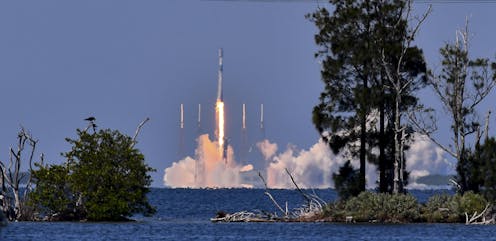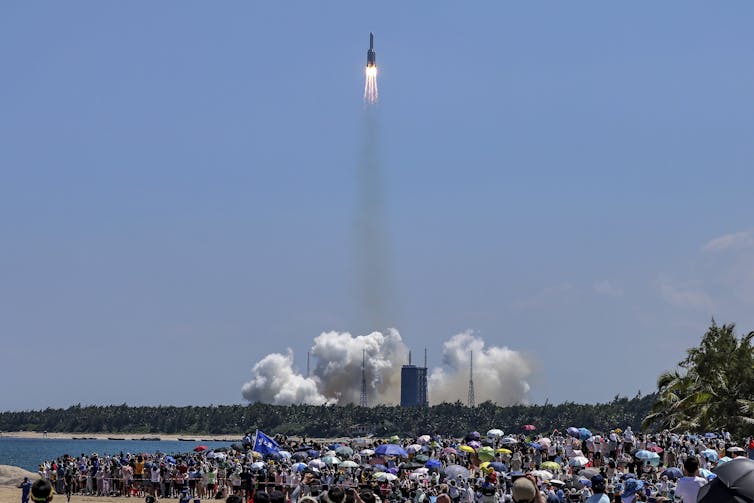
On May 11, 2020 a deadly threat flew from Los Angeles to New York City in under nine minutes. It was a 20-tonne Chinese Long March 5B rocket body passing around 60 miles overhead.
Just 15 minutes later, the rocket body re-entered the atmosphere and broke into pieces, including a 12-metre-long pipe that crashed into a village in the Ivory Coast.
The rocket body had completed its mission and been abandoned in orbit, left to return to the surface in an uncontrolled way. It posed an indiscriminate threat to people across the globe — on the ground, at sea, and in aircraft in flight. The probability of a lethal impact was very small, but the consequences could have been severe.
Weighing cost against risk
At the time, the Federal Aviation Administration (FAA) decided not to close U.S. airspace — denying planes permission to fly within a designated area — along the rocket body’s path. The timeframe for making such a decision was very short and fraught with uncertainty, while the economic costs to airlines and passengers were certain and large.
In circumstances like these, decision-makers have to weigh the economic costs against taking no action but accepting a small probability of casualties. The FAA chose the latter.
On Nov. 4, 2022, Spain and France closed parts of their airspace for 40 and 60 minutes respectively, as another Chinese Long March 5B rocket body was due to re-enter the atmosphere uncontrolled. The rocket body passed harmlessly overhead, before breaking up over the Pacific Ocean.
More than 300 flights were disrupted by the Spanish airspace closure alone, costing airlines and passengers millions of Euros.
Which approach was correct? Nobody likes delays, yet we all expect airlines and regulators to put safety first. Nevertheless, why are aviation agencies being forced to make these decisions at all?
No confirmed instances
An aircraft in flight could be seriously damaged by just 300 grams of space debris impacting an engine, windshield or other critical surface. Although there are no confirmed instances of space debris hitting an aircraft in flight, in 1996 the windscreen of a Boeing 757 was cracked by an unknown object while flying at 31,500 feet.
In 2013, another Boeing 757 had one side of its nose-cone punched in by an unidentified object while flying at 26,000 feet. Bird strikes were unlikely in these instances.
There’s no need for any of us to worry. The probability of an airplane being struck by space debris is extremely small — much smaller than a bird strike.

But even very small probabilities can have severe consequences that justify regulatory action. In 2021, the AstraZeneca COVID-19 vaccine was linked to a very small risk of blood clots — a total of 222 cases among 34 million people, or 0.0007 per cent.
A number of countries responded by curtailing and, in the case of the U.S., not licensing the use of AstraZeneca, thus favoring more expensive MRNA vaccines .
Today, two factors combine to increase the probability of an airplane being struck by space debris: increasing air traffic and increasing uses of space. COVID-19 aside, the number of airline flights each year has doubled since the millennium.
In just the last four years the number of active and defunct satellites in low Earth orbit has also doubled, from approximately 3,000 to more than 8,000.
Controlled versus uncontrolled
Satellites are launched using rockets, and while some rocket bodies are brought back to Earth in a controlled manner, many are simply abandoned in orbit.
Uncontrolled re-entries occur because objects orbiting at low enough altitudes still feel the effects of the uppermost portions of Earth’s atmosphere, creating a drag that ensures an eventual re-entry. Predicting these re-entries is very difficult due to a myriad of factors that include variations in the atmosphere itself.
In contrast, a controlled re-entry is performed by using an engine burn that directs the rocket body to a remote area of ocean or a recovery zone. Some fuel must be retained in the rocket body for this purpose, and the engines must be able to reignite.
Yet many operators still choose to use uncontrolled re-entries, presumably to avoid the additional costs associated with technological upgrades and extra fuel.
Even SpaceX, an industry leader in technology development, sometimes abandons the second stages of its rockets after lifting satellites destined for geosynchronous orbit. In 2016, two pressure vessels — each the size of a washing machine — from one such stage reached the ground intact, landing in Indonesia.
Aviation bodies are taking notice, including the International Civil Aviation Organization and the Air Line Pilots Association.
In March 2023, the Montréal Recommendations on Aviation Safety and Uncontrolled Space Object Reentries were released. The recommendations were compiled by international experts, including the Inspector General of the French Space Agency and the Chief of Space Safety in the U.S. Department of the Air Force.
Recognizing that the “use of space by any single state has global implications, with risks potentially exported from launching states to other states,” the recommendations call on states to “establish requirements to avoid uncontrolled re-entries of space objects.”
Will it take a major accident, such as a catastrophic strike to an airplane, before public concern forces governments to require that all rocket bodies be brought back to Earth in a controlled manner?
Successful policies
We’ve been here before. In the 1970s, a growing risk to oceans from oil spills led to calls for a requirement for double hulls on tankers. The shipping industry, concerned about increased costs, was able to stifle these efforts — until 1989, when the Exxon Valdez spilled roughly 11 million gallons of oil into Alaska’s Prince William Sound.
Suddenly, the issue of oil spills was a matter of public concern, and after the National Transportation Safety Board concluded that a double hull would have substantially reduced if not eliminated the spill, the U.S. government required all new tankers calling at U.S. ports to have double hulls.
This unilateral move prompted the International Maritime Organization to amend the International Convention for the Prevention of Pollution from Ships in 1992 to require double hulls on new tankers. And, through further amendments in 2001 and 2003, to accelerate the retirement of single-hulled tankers.
The 1992 amendment has since been ratified by 150 nations representing 98 per cent of the world’s shipping tonnage.
One of the most informative aspects of this precedent is that the U.S. adopted a double-hull requirement before any other nation, and this move then prompted successful multilateral law-making.
Today, uncontrolled rocket body re-entries are another international safety issue where the U.S. could lead.
The FAA licenses the majority of the world’s space launches and regulates one of the largest aviation industries. It is perfectly positioned to spur international change — before an airplane full of passengers is struck from the sky.
This is a corrected version of a story originally published on March 29. The earlier story said that the Montréal Recommendations on Aviation Safety and Uncontrolled Space Object Reentries was published in 2022 instead of 2023.
Michael Byers receives funding from the Canada Research Chairs Program, Social Sciences and Humanities Research Council of Canada, Natural Sciences and Engineering Research Council of Canada, New Frontiers in Research Fund, and the Department of National Defence. He is affiliated with the Outer Space Institute and the Salt Spring Forum.
Aaron Boley receives funding from the Canada Research Chairs Program, Natural Sciences and Engineering Research Council of Canada, New Frontiers in Research Fund, and the Department of National Defence. He is affiliated with the Outer Space Institute.
This article was originally published on The Conversation. Read the original article.







